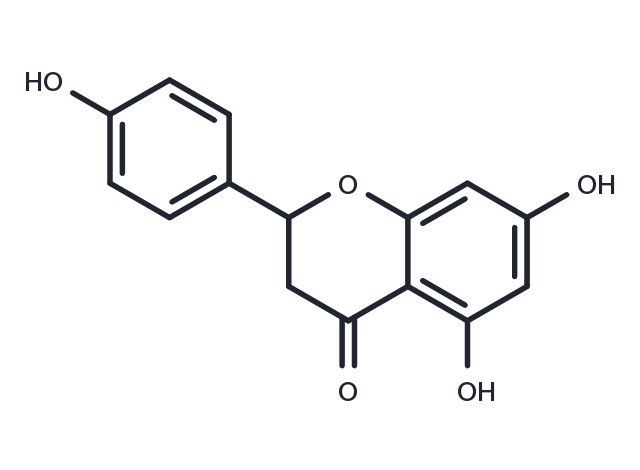Powder: -20°C for 3 years | In solvent: -80°C for 1 year


(±)-Naringenin (Naringenine) is a natural product. It displays vasorelaxant effect on endothelium-denuded vessels via the activation of BKCa channels in myocytes.

| Pack Size | Availability | Price/USD | Quantity |
|---|---|---|---|
| 100 mg | In stock | $ 45.00 | |
| 1 mL * 10 mM (in DMSO) | In stock | $ 50.00 |


| Description | (±)-Naringenin (Naringenine) is a natural product. It displays vasorelaxant effect on endothelium-denuded vessels via the activation of BKCa channels in myocytes. |
| In vivo | (+/-)-Naringenin induced concentration-dependent relaxation in endothelium-denuded rat aortic rings pre-contracted with either 20 mM KCl or noradrenaline (pIC(50) values of 4.74 and 4.68, respectively).?Tetraethylammonium, iberiotoxin, 4-aminopyridine and 60 mM KCl antagonised (+/-)-naringenin-induced vasorelaxation, while glibenclamide did not produce any significant antagonism.?Naringin [(+/-)-naringenin 7-beta-neohesperidoside] caused a concentration-dependent relaxation of rings pre-contracted with 20 mM KCl, although its potency and efficacy were significantly lower than those of (+/-)-naringenin.?In rat tail artery myocytes, (+/-)-naringenin increased large conductance Ca(2+)-activated K(+) (BK(Ca)) currents in a concentration-dependent manner;?this stimulation was iberiotoxin-sensitive and fully reversible upon drug wash-out.?(+/-)-Naringenin accelerated the activation kinetics of BK(Ca) current, shifted, by 22 mV, the voltage dependence of the activation curve to more negative potentials, and decreased the slope of activation.?(+/-)-Naringenin-induced stimulation of BK(Ca) current was insensitive either to changes in the intracellular Ca(2+) concentration or to the presence, in the pipette solution, of the fast Ca(2+) chelator BAPTA.?However, such stimulation was diminished when the K(+) gradient across the membrane was reduced. |
| Cell Research | Naringenin is dissolved in DMSO and diluted in cell culture medium. The cells are rinsed with PBS and grown in a medium containing various concentrations of naringenin (50, 100, 150, 200, 250, 300 μM). The solvent DMSO treated cells are served as control. After 24 hrs of treatment, the medium is removed and replaced by another medium containing MTT. Cell viability is measured using the MTT assay[1]. |
| Synonyms | Salipurpol, Naringenine, Naringenin |
| Molecular Weight | 272.25 |
| Formula | C15H12O5 |
| CAS No. | 67604-48-2 |
Powder: -20°C for 3 years | In solvent: -80°C for 1 year
H2O: < 0.1 mg/mL (insoluble)
DMSO: 120 mg/mL (440.77 mM), Sonication is recommended.
You can also refer to dose conversion for different animals. More
bottom
Please see Inhibitor Handling Instructions for more frequently ask questions. Topics include: how to prepare stock solutions, how to store products, and cautions on cell-based assays & animal experiments, etc.
(±)-Naringenin 67604-48-2 Membrane transporter/Ion channel Potassium Channel inhibit (±)Naringenin myocytes Salipurpol vasorelaxant Naringenine (±) Naringenin Inhibitor KcsA Naringenin inhibitor
